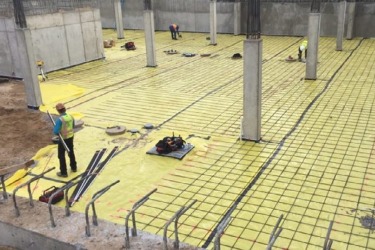You can erect nearly anything with steel: homes, shops, hangars, factories, warehouses, high rises, entertainment/sports arenas and shopping malls. The inherent compressive and tensile properties of steel lend more versatility to architectural design than any other conventional framing system. Whether you want height, light, creative angles or vast, unsupported spans, steel framing fits just about any bill.
While more simple buildings, such as hangars and barns, can be prefabricated and assembled on-site as kits, more complex structures require custom steel created to specifications. These parts come from your steel fabricator who acquires the milled metal then customizes the steel framing building components exactly as you require them, piece by piece.
With any steel structure, you have primary framing and secondary framing. What are the common members of each, and what do they do?
PRIMARY FRAMING
The primary framing consists of all the elements that, combined, will carry the gravity — or vertical — loads of the building to the foundation. Without the complete primary frame, the building would not stand up to vertical or lateral loads over time. It provides the bones upon which the rest of the framing attaches. Because the main frame bears the dead weight of the building — and the live loads when it’s in use — almost all its members will be hot-rolled structural steel. The following items, bolted or welded together, form the superstructure:
- Columns: The vertical supports. Columns can come shaped as tubes or with a cross-sectional shape of a capital H, I, L or U.
- Beams: The horizontal supports that rest atop the columns. Usually I or H-shaped with flanges perpendicular to the “web” or main plate.
- Rafters: Also beams, these horizontal members support the roof assembly.
- Trusses and Lattice Girders: Alternative support for the roof or upper floors, comprised of a latticework of bracing metal between top and bottom chords. While the chords bear compression and tension loads, the bracing resists shear forces.
- Girders: Horizontal beams that support floors.
- Clips: Steel plates welded to the main members which provide connection points between members.
- Anchor Bolts: The bolts that fasten the columns to the foundation.
SECONDARY FRAMING
Secondary framing, fills in where structural steel isn’t necessary. Providing the stabilizing members that prevent the main frame from twisting out of shape, secondary components can also contribute to the structural support and provide the means to attach wall, roof and interior elements. The secondary framing usually transfers loads to the main frame.
Because the secondary schema need not hold the gravity loads, its members take shape from cold-rolled sheet steel. The metal passes through rollers to configure cross-sectional shapes such as C, Z, U, L or V. Special curling inward of the edges can create a stronger length of metal. Also, the 12 to 16-gauge sheets of steel can be fabricated to conform to custom requirements more complicated than the basic letter shapes. The common secondary framing parts include:
- Studs: The vertical posts for interior drywall attachment.
- Tracks: C-shaped channels into which you anchor the studs.
- Struts: A brace stabilizer that takes loads along its axis.
- Girts: Horizontal stabilizer bars between exterior columns. Wall cladding attaches to these.
- Purlins: Horizontal stabilizers between the rafters to which the roof assembly is attached.
- Eave Struts: The transition piece between the wall girts and roof purlins along the eave.
- Wall Bracing: Bars, cables rods or strips that resist shearing and contribute more lateral stability.
- Flange Bracing: Bracing metal to prevent rafters from rolling side to side.
- Joists: Floor support beams.
- Headers and Jambs: The framework for openings such as doors, windows and bays.
Along with the foregoing elements of steel framing, a project will require a multitude of fasteners, some common, others custom.
STEEL FRAMING COMPONENTS FOR THE FRONT RANGE
Barton Supply stands ready to provide all of your steel framing components, whether primary or secondary. Our experienced team can help you coordinate your project from the ground up. With estimators, coordinators, project managers and fabricators working diligently for you, all your Front Range steel framing building components exist right here at your fingertips.
